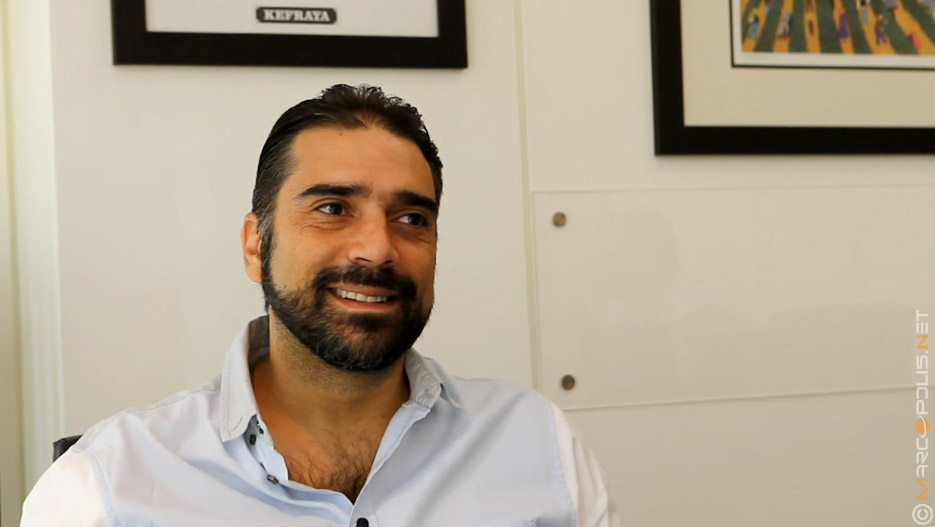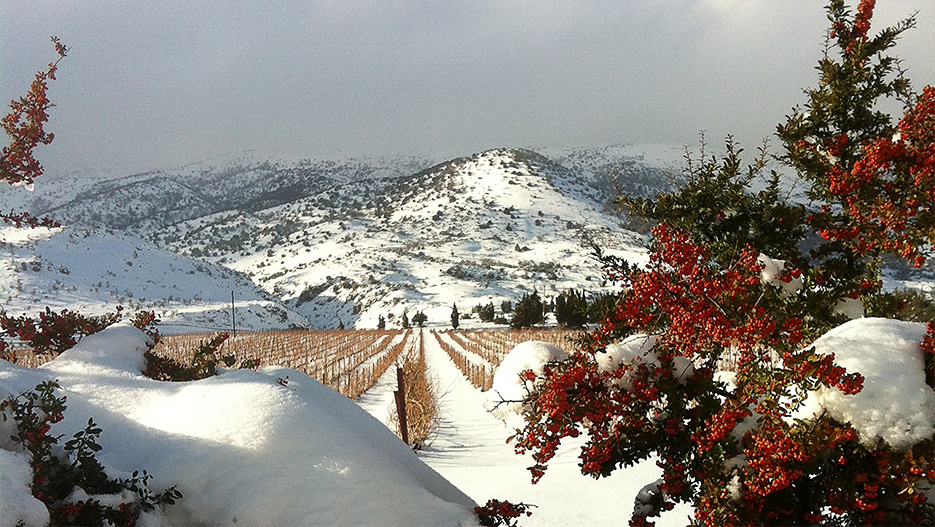Château Kefraya: Increased Number of Wine Producers Is Turning Lebanon into A Major Wine-Producing Country
The trend in Lebanon is that there is certainly more and more interest in wine in general. The increase in the number of wineries proves this.
Interview with Emile Majdalani, Commercial Director of Chateau Kefraya

Let’s start with the current situation with regards to the wine industry in Lebanon. What are the main trends for 2015 and 2016 when it comes to wine in Lebanon?
The trend in Lebanon is that there is certainly more and more interest in wine in general. The increase in the number of wineries proves this. At the same time, the economy is quite difficult, basically because of the situation around Lebanon that is absolutely catastrophic… Having said that we have lived tougher times than this so we are used to it; we are used to always manage to work, to harvest and to give birth to every vintage. It is the story of Lebanon, at the end of the day it has never really been stable. I have to admit that the last years have been particularly difficult locally. But we tend to balance things and to compensate with our exports that are doing very well.
There have been entries of new wine producers. How is it affecting the overall competitiveness of the country?
It is good for the country in general because it means Lebanon becomes a major wine-producing country. It is important for Lebanon to have an increase in the number of wineries to become a real player on the international wine scene. 50 years ago, there were only 5 or 6 wineries and now there are about 45. This creates variety and an additional interest; specifically when the wine is good, it is a strength for the industry I think.
How does Chateau Kefraya fit into the picture? What have been the developments since 2012?
There have been a lot of developments. Actually at Kefraya we have been reworking the whole range over the last years. We have been lifting our labels but also creating new wines because we looked at the range and questioned ourselves. We saw where there were opportunities, for example our entry level Les Bretèches that is internationally known is now declined into three colours: we have Les Bretèches red, white and rosé. This is added value for the brand certainly. We had the ‘’Chateau Kefraya’’ and the ‘’Bretèches’’; the Chateau being a full bodied, high end wine and Les Bretèches the entry level, fruity and easy to drink. There was some space in between for an intermediary red wine and that is why we created ‘’Les Coteaux’’ that is a slightly wooden red wine with new varieties introduced like Marselan and Cabernet Franc and thus a different specificity. So as I said, we have been reworking the range and expanding it to meet a wider range of consumers all over the world.
What has been the reaction from the consumers?
Even if in a given year we have 50% less in production (which is the case of 2015), we will never compensate with purchases and this is a very important element of our philosophy.
The reaction has been that our exports have developed a lot, for example in the United States we are now present in above 25 states, among which California, Pennsylvania, New York and Florida. The French market which is our number 1 market has been developed a lot as well. Historically we were first sold in the Lebanese restaurants, but today we are being well established in the classical French market, namely in high-end local restaurants, liquor stores. We had entered about 25 export markets in 2010, today we are present in 40. Since our production is limited (we do not buy grapes and only use only our own terroir’s harvest), we must select our channels carefully when conquering a new market. We always go through the best channels and to the middle-to-high-end restaurants and liquor stores, more than the off-trade and supermarkets, because we don’t have the volumes for that. Even if in a given year we have 50% less in production (which is the case of 2015), we will never compensate with purchases and this is a very important element of our philosophy. We grow and take care of every grape dedicated to our wines.

Apart from the expansion in the United States, is there any other specific market that you are looking into right now?
India interests us a lot and China as well. We think this will come with time. We already export a little bit to these wine-emerging countries and it is just a matter of time. Again, our production is limited so the scope is not infinite. We produce today 1.3 million bottles, which is not small relatively to Lebanon, but the wine range is wide and diverse and we work every label with a boutique winery spirit.
Is the priority export destination the United States? Where do you think you have to focus your attention?
There are markets like Great Britain, France and the U.S., where it is certainly important image-wise to be solidly present. Chateau Kefraya’s choices in terms of exports are directed to markets where there is an interest in let´s not say ‘’New World’’ wines but more ‘’Ancient World’’ wines; since Lebanon – as a wine-growing territory – is indeed part of the ancient world. As you might know 5,000 years ago we used to grow vines in Lebanon, our ancestors, the Phoenicians, used to even export their wine to Egypt, it is a very old tradition here. We recently discovered a Roman mill in Kefraya that is filled with historical vestiges…
Each year you designate a different local artist to draft the design of one of your products; could you tell us more about that? Also what do you do locally to distinguish yourselves?
Actually art and culture has always been associated with the brand, because we simply believe that wine and art are intimately related. Our founder and owner Michel de Bustros is very passionate about opera, paintings and art in general. There is reference to art in our different labels. Since last year, we decided to move the experience further and to give total liberty to an artist to design a label for our red wine ‘’Les Bretèches’’. It is a special and limited edition, which we launch for every vintage with a new innovative Lebanese artist. Last year it was with painter and illustrator Mazen Kerbaj. This year it is Yazan Halwani, a young and unique street artist that paints murals that are very well known in Beirut’s streets. He normally does portraits of people of Lebanese culture who had a positive influence on the city of Beirut. He merges the portraits to his own pattern of calligraphy. His painting for ‘’Les Bretèches’’ was called ‘’Bakhos’’, which is the Arabic name for Bacchus, the Roman god of wine, that has deep ties with the Bekaa Valley’s culture. It was a message.
Let’s touch upon your oenotourism program at your premises. We know you added new activities for the visitors.
Yes it has been developed a lot recently. Our restaurant ‘’Le Relais Dionysos’’ has always existed and we have developed more wine-educational activities. A person today could come to Kefraya and easily spend a whole day learning and getting the feel of the winery. Today we go more in depth in explaining our winemaking-approach, we take visitors to our terroir; we show them the vines and the difference between the different soils and grape varieties. The scope has been widened a lot in spite of the situation, because it has been quite difficult to invest in these times, especially in the Bekaa Valley, as people sometimes think that it is unsafe to go there. This is actually not true; the West Bekaa is quite stable and there is no real danger in going there…
You allegedly plan to build a hotel in the near future.
We planned to build a boutique hotel so that people could spend the night in Kefraya. We still have this project in mind but we decided to postpone it a little bit until the situation becomes more stable, which is something we hope for but that is not in our hands.
What is your strategic vision for the winery?
We have a limited terroir and thus a limited amount of grapes. Even if we acquired more lands, they would have to necessarily be within the boundaries of the ‘’Kefraya’’ commune because we work like an AOC (Appellation d´Origine Contrôlée), although there is no AOC-system in Lebanon yet. In spite of that, we impose this rigor on ourselves for the sake of quality and most of all, to respect our own terroir’s inherent expression. The strategic vision is not to remain a leading winery in Lebanon, but to build a strong reputation among the world’s most authentic and greatest wineries.
What distinguishes Kefraya amongst the growing number of producers?
In Kefraya and for every single vintage, we do a lot of research. Lately we have been digging huge pedologic holes on the terroir’s different spots to study its geological history and to better understand the differences in soils’ composition. Within one single parcel for example, you have a huge variety in terms of terroir potentials. Defining these ‘’micro-parcels’’ allowed us to be more accurate in the way we allocate the grapes to each wine. We have been working with universities that will be publishing theses of this research. In addition to owning and fully-controlling our vines, I would say that we demark ourselves in terms of accuracy. The purpose is to always know our terroir’s essence better and to create wines that reflect it the best possible way.
Tell us about the wines Comte de M and the Comtesse.
Comte de M is a different story; it is separate from the wine range. Comte de M is an entity in itself. It is a wine that became famous when we got the 91 rating from Parker in 1996. Today we have obtained a 92 rate over the three last vintages. Comte de M is really made from a tight selection of the best micro-terroirs’ grapes in Kefraya, these are grown in high altitude, where there are big differences in temperature between day and night, and thus a better maturation of the grapes. This is where we put all of our best knowhow with the best choice of grapes but also of barrels.
After several years of research and trials, we decided to launch a white wine of the same standing and we called it ‘’Comtesse de M’’. In Lebanon, white wines often lack a bit of acidity and there is an intended choice not to adjust them by any addition of tartaric acid. To ensure an optimal and longer life span to Comtesse de M, we wished to create a white wine marked by a longer maturation in barrels, because there was sufficient ‘’matière’’ and volume to absorb this supply well. With 24 months of new oak barrel, we also made sure that the wood is not too opulent. Comtesse de M is a challenge taken by the winemaker to experience how far we can go with a white in Lebanon. As our winemaker Fabrice Guiberteau always says, ‘’we keep on advancing quality wise, while always keeping in mind that wine requires a lot of humility and we never get 100% of the targeted result’’. Only 2,000 bottles are produced on 2 to 3 hectares and it is added value for the portfolio.